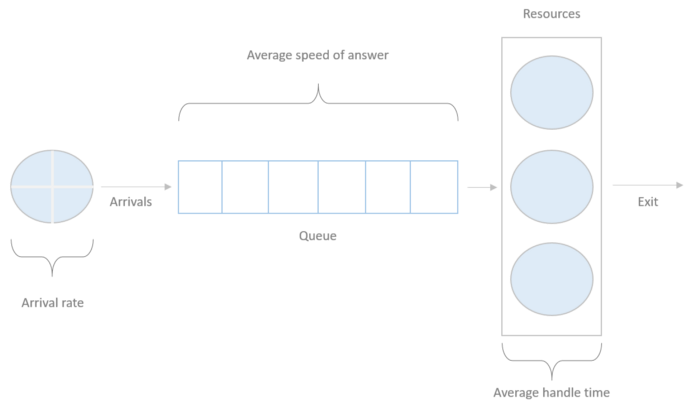



pyworkforce
Standard tools for workforce management, queuing, scheduling, rostering and optimization problems.
Make sure to check the documentation, which is available here
Usage:
Install pyworkforce
It's advised to install pyworkforce using a virtual env, inside the env use:
pip install pyworkforce
If you are having troubles with or-tools installation, check the or-tools guide
For complete list and details of examples go to the
examples folder
Features:
pyworkforce currently includes:
Queuing
It solves the following system resource requirements:

- queuing.ErlangC: Find the number of resources required to attend incoming traffic to a constant rate,
infinite queue length, and no dropout.
Scheduling
It finds the number of resources to schedule in a shift based on the number of required positions per time interval
(found, for example, using queuing.ErlangC), maximum capacity restrictions and static shifts coverage.
- scheduling.MinAbsDifference: This module finds the "optimal" assignation by minimizing the total absolute
differences between required resources per interval against the scheduled resources found by the solver.
- scheduling.MinRequiredResources: This module finds the "optimal" assignation by minimizing the total
weighted amount of scheduled resources (optionally weighted by shift cost), it ensures that in all intervals, there are
never fewer resources shifted than the ones required per period.
Rostering
It assigns a list of resources to a list of required positions per day and shifts; it takes into account
different restrictions as shift bans, consecutive shifts, resting days, and others.
It also introduces soft restrictions like shift preferences.
Queue systems:
A brief introduction can be found in this medium post
Example:
from pyworkforce.queuing import ErlangC
erlang = ErlangC(transactions=100, asa=20/60, aht=3, interval=30, shrinkage=0.3)
positions_requirements = erlang.required_positions(service_level=0.8, max_occupancy=0.85)
print("positions_requirements: ", positions_requirements)
Output:
>> positions_requirements: {'raw_positions': 14,
'positions': 20,
'service_level': 0.8883500191794669,
'occupancy': 0.7142857142857143,
'waiting_probability': 0.1741319335950498}
If you want to run different scenarios at the same time, you can use the MultiErlangC, for example, trying different service levels:
from pyworkforce.queuing import MultiErlangC
param_grid = {"transactions": [100], "aht": [3], "interval": [30], "asa": [20 / 60], "shrinkage": [0.3]}
multi_erlang = MultiErlangC(param_grid=param_grid, n_jobs=-1)
required_positions_scenarios = {"service_level": [0.8, 0.85, 0.9], "max_occupancy": [0.8]}
positions_requirements = multi_erlang.required_positions(required_positions_scenarios)
print("positions_requirements: ", positions_requirements)
Output:
>> positions_requirements: [
{
"raw_positions": 13,
"positions": 19,
"service_level": 0.7955947884177831,
"occupancy": 0.7692307692307693,
"waiting_probability": 0.285270453036493
},
{
"raw_positions": 14,
"positions": 20,
"service_level": 0.8883500191794669,
"occupancy": 0.7142857142857143,
"waiting_probability": 0.1741319335950498
},
{
"raw_positions": 15,
"positions": 22,
"service_level": 0.9414528428690223,
"occupancy": 0.6666666666666666,
"waiting_probability": 0.10204236700798798
}
]
Scheduling
A brief introduction can be found in this medium post
Example:
from pyworkforce.scheduling import MinAbsDifference, MinRequiredResources
required_resources = [
[9, 11, 17, 9, 7, 12, 5, 11, 8, 9, 18, 17, 8, 12, 16, 8, 7, 12, 11, 10, 13, 19, 16, 7],
[13, 13, 12, 15, 18, 20, 13, 16, 17, 8, 13, 11, 6, 19, 11, 20, 19, 17, 10, 13, 14, 23, 16, 8]
]
shifts_coverage = {"Morning": [0, 0, 0, 0, 0, 1, 1, 1, 1, 1, 1, 1, 1, 0, 0, 0, 0, 0, 0, 0, 0, 0, 0, 0],
"Afternoon": [0, 0, 0, 0, 0, 0, 0, 0, 0, 0, 0, 0, 0, 1, 1, 1, 1, 1, 1, 1, 1, 0, 0, 0],
"Night": [1, 1, 1, 1, 1, 0, 0, 0, 0, 0, 0, 0, 0, 0, 0, 0, 0, 0, 0, 0, 0, 1, 1, 1],
"Mixed": [0, 0, 0, 0, 0, 0, 0, 0, 0, 1, 1, 1, 1, 1, 1, 1, 1, 0, 0, 0, 0, 0, 0, 0]}
difference_scheduler = MinAbsDifference(num_days=2,
periods=24,
shifts_coverage=shifts_coverage,
required_resources=required_resources,
max_period_concurrency=27,
max_shift_concurrency=25)
difference_solution = difference_scheduler.solve()
requirements_scheduler = MinRequiredResources(num_days=2,
periods=24,
shifts_coverage=shifts_coverage,
required_resources=required_resources,
max_period_concurrency=27,
max_shift_concurrency=25)
requirements_solution = requirements_scheduler.solve()
print("difference_solution :", difference_solution)
print("requirements_solution :", requirements_solution)
Output:
>> difference_solution: {'status': 'OPTIMAL',
'cost': 157.0,
'resources_shifts': [{'day': 0, 'shift': 'Morning', 'resources': 8},
{'day': 0, 'shift': 'Afternoon', 'resources': 11},
{'day': 0, 'shift': 'Night', 'resources': 9},
{'day': 0, 'shift': 'Mixed', 'resources': 1},
{'day': 1, 'shift': 'Morning', 'resources': 13},
{'day': 1, 'shift': 'Afternoon', 'resources': 17},
{'day': 1, 'shift': 'Night', 'resources': 13},
{'day': 1, 'shift': 'Mixed', 'resources': 0}]
}
>> requirements_solution: {'status': 'OPTIMAL',
'cost': 113.0,
'resources_shifts': [{'day': 0, 'shift': 'Morning', 'resources': 15},
{'day': 0, 'shift': 'Afternoon', 'resources': 13},
{'day': 0, 'shift': 'Night', 'resources': 19},
{'day': 0, 'shift': 'Mixed', 'resources': 3},
{'day': 1, 'shift': 'Morning', 'resources': 20},
{'day': 1, 'shift': 'Afternoon', 'resources': 20},
{'day': 1, 'shift': 'Night', 'resources': 23},
{'day': 1, 'shift': 'Mixed', 'resources': 0}]}





